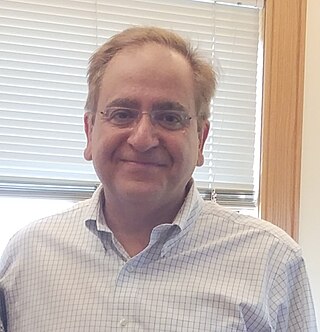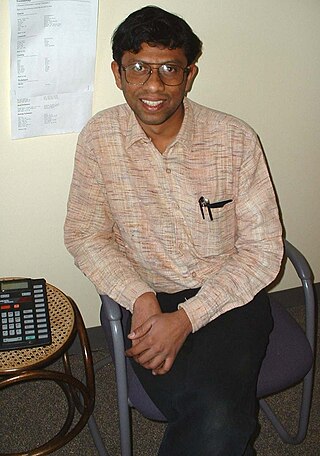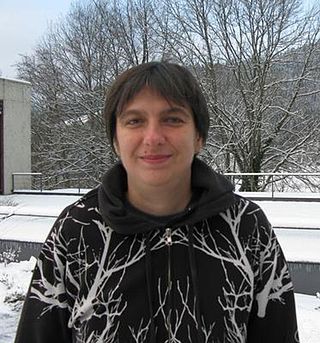Related Research Articles
M-theory is a theory in physics that unifies all consistent versions of superstring theory. Edward Witten first conjectured the existence of such a theory at a string theory conference at the University of Southern California in 1995. Witten's announcement initiated a flurry of research activity known as the second superstring revolution. Prior to Witten's announcement, string theorists had identified five versions of superstring theory. Although these theories initially appeared to be very different, work by many physicists showed that the theories were related in intricate and nontrivial ways. Physicists found that apparently distinct theories could be unified by mathematical transformations called S-duality and T-duality. Witten's conjecture was based in part on the existence of these dualities and in part on the relationship of the string theories to a field theory called eleven-dimensional supergravity.
In physics, string theory is a theory that attempts to merge quantum mechanics with Einstein’s general theory of relativity. The theory puts forth the premise of the material universe being made of tiny one-dimensional “strings”, rather than the more conventional approach in which they are modeled as zero-dimensional point particles. String theory envisions that a string undergoing a particular mode of vibration corresponds to a particle with definite properties such as mass and charge.

Edward Witten is an American mathematical and theoretical physicist. He is a professor emeritus in the school of natural sciences at the Institute for Advanced Study in Princeton. Witten is a researcher in string theory, quantum gravity, supersymmetric quantum field theories, and other areas of mathematical physics. Witten's work has also significantly impacted pure mathematics. In 1990, he became the first physicist to be awarded a Fields Medal by the International Mathematical Union, for his mathematical insights in physics, such as his 1981 proof of the positive energy theorem in general relativity, and his interpretation of the Jones invariants of knots as Feynman integrals. He is considered the practical founder of M-theory.
In theoretical physics, S-duality is an equivalence of two physical theories, which may be either quantum field theories or string theories. S-duality is useful for doing calculations in theoretical physics because it relates a theory in which calculations are difficult to a theory in which they are easier.
In theoretical physics, the matrix theory is a quantum mechanical model proposed in 1997 by Tom Banks, Willy Fischler, Stephen Shenker, and Leonard Susskind; it is also known as BFSS matrix model, after the authors' initials.
In algebraic geometry and theoretical physics, mirror symmetry is a relationship between geometric objects called Calabi–Yau manifolds. The term refers to a situation where two Calabi–Yau manifolds look very different geometrically but are nevertheless equivalent when employed as extra dimensions of string theory.
In mathematics and string theory, a conifold is a generalization of a manifold. Unlike manifolds, conifolds can contain conical singularities, i.e. points whose neighbourhoods look like cones over a certain base. In physics, in particular in flux compactifications of string theory, the base is usually a five-dimensional real manifold, since the typically considered conifolds are complex 3-dimensional spaces.

Cumrun Vafa is an Iranian-American theoretical physicist and the Hollis Professor of Mathematicks and Natural Philosophy at Harvard University.
The mathematical term perverse sheaves refers to the objects of certain abelian categories associated to topological spaces, which may be a real or complex manifold, or more general topologically stratified spaces, possibly singular.
In string theory, K-theory classification refers to a conjectured application of K-theory to superstrings, to classify the allowed Ramond–Ramond field strengths as well as the charges of stable D-branes.
In theoretical particle physics, the non-commutative Standard Model, is a model based on noncommutative geometry that unifies a modified form of general relativity with the Standard Model.

Rajesh Gopakumar is an Indian theoretical physicist and the director of the International Centre for Theoretical Sciences (ICTS-TIFR) in Bangalore, India. He was previously a professor at Harish-Chandra Research Institute (HRI) in Prayagraj, India. He is known for his work on topological string theory.

In strong interaction physics, light front holography or light front holographic QCD is an approximate version of the theory of quantum chromodynamics (QCD) which results from mapping the gauge theory of QCD to a higher-dimensional anti-de Sitter space (AdS) inspired by the AdS/CFT correspondence proposed for string theory. This procedure makes it possible to find analytic solutions in situations where strong coupling occurs, improving predictions of the masses of hadrons and their internal structure revealed by high-energy accelerator experiments. The most widely used approach to finding approximate solutions to the QCD equations, lattice QCD, has had many successful applications; however, it is a numerical approach formulated in Euclidean space rather than physical Minkowski space-time.
Nikita Alexandrovich Nekrasov is a Russian mathematical and theoretical physicist at the Simons Center for Geometry and Physics and C.N.Yang Institute for Theoretical Physics at Stony Brook University in New York, and a Professor of the Russian Academy of Sciences.

Matilde Marcolli is an Italian and American mathematical physicist. She has conducted research work in areas of mathematics and theoretical physics; obtained the Heinz Maier-Leibnitz-Preis of the Deutsche Forschungsgemeinschaft, and the Sofia Kovalevskaya Award of the Alexander von Humboldt Foundation. Marcolli has authored and edited numerous books in the field. She is currently the Robert F. Christy Professor of Mathematics and Computing and Mathematical Sciences at the California Institute of Technology.

Richard Paul Winsley Thomas is a British mathematician working in several areas of geometry. He is a professor at Imperial College London. He studies moduli problems in algebraic geometry, and ‘mirror symmetry’—a phenomenon in pure mathematics predicted by string theory in theoretical physics.
In theoretical physics, Rajesh Gopakumar and Cumrun Vafa introduced in a series of papers new topological invariants, called Gopakumar–Vafa invariants, that represent the number of BPS states on a Calabi–Yau 3-fold. They lead to the following generating function for the Gromov–Witten invariants on a Calabi–Yau 3-fold M:

Mina Aganagić is a mathematical physicist who works as a professor in the Center for Theoretical Physics, the Department of Mathematics, the Department of Physics at the University of California, Berkeley.
Paul Stephen Aspinwall is a British theoretical physicist and mathematician, who works on string theory and also algebraic geometry.
Xenia de la Ossa Osegueda is a theoretical physicist whose research focuses on mathematical structures that arise in string theory. She is a professor at Oxford's Mathematical Institute.
References
- ↑ homepage of Sheldon Katz at the University of Illinois at Urbana-Champaign
- ↑ Sheldon Katz at the Mathematics Genealogy Project
- ↑ Katz, Sheldon H. | Institute for Advanced Study
- ↑ Batyrev, V. (2000). "Review: Mirror symmetry and algebraic geometry by David A. Cox and Sheldon Katz" (PDF). Bull. Amer. Math. Soc. (N.S.). 37 (4): 473–476. doi: 10.1090/s0273-0979-00-00875-2 .
- ↑ William J. Satzer (11 July 2006). "Review: Enumerative Geometry and String Theory by Sheldon Katz". Mathematical Association of America.
- ↑ "Review: Enumerative Geometry and String Theory". European Mathematical Society. 23 October 2011.